Analysis of Nestle's Marketing Principles and Strategies in the UK
VerifiedAdded on 2022/08/27
|18
|4145
|38
Report
AI Summary
This report provides a comprehensive analysis of Nestle's marketing principles, focusing on its performance in the UK market. It begins with an overview of Nestle, its history, and its global presence, including its diverse product portfolio and financial performance. The report then delves into macro factors, such as political, economic, social, technological, environmental, and legal factors (PESTEL analysis), and micro factors, including strengths, weaknesses, opportunities, and threats (SWOT analysis), impacting Nestle's business. It identifies the company's target audiences, market positioning, and corporate social responsibility initiatives. Furthermore, the report examines Nestle's marketing strategies, including segmentation, targeting, and positioning, and concludes with recommendations for future growth and success. The report also highlights Nestle's brand recognition, global presence, diversified product portfolio, digital marketing, and e-commerce strategies. It also acknowledges the threats faced by Nestle, such as rising raw material costs, water scarcity, and competitive pressures. The analysis is based on the assignment brief which required a focus on the UK market.
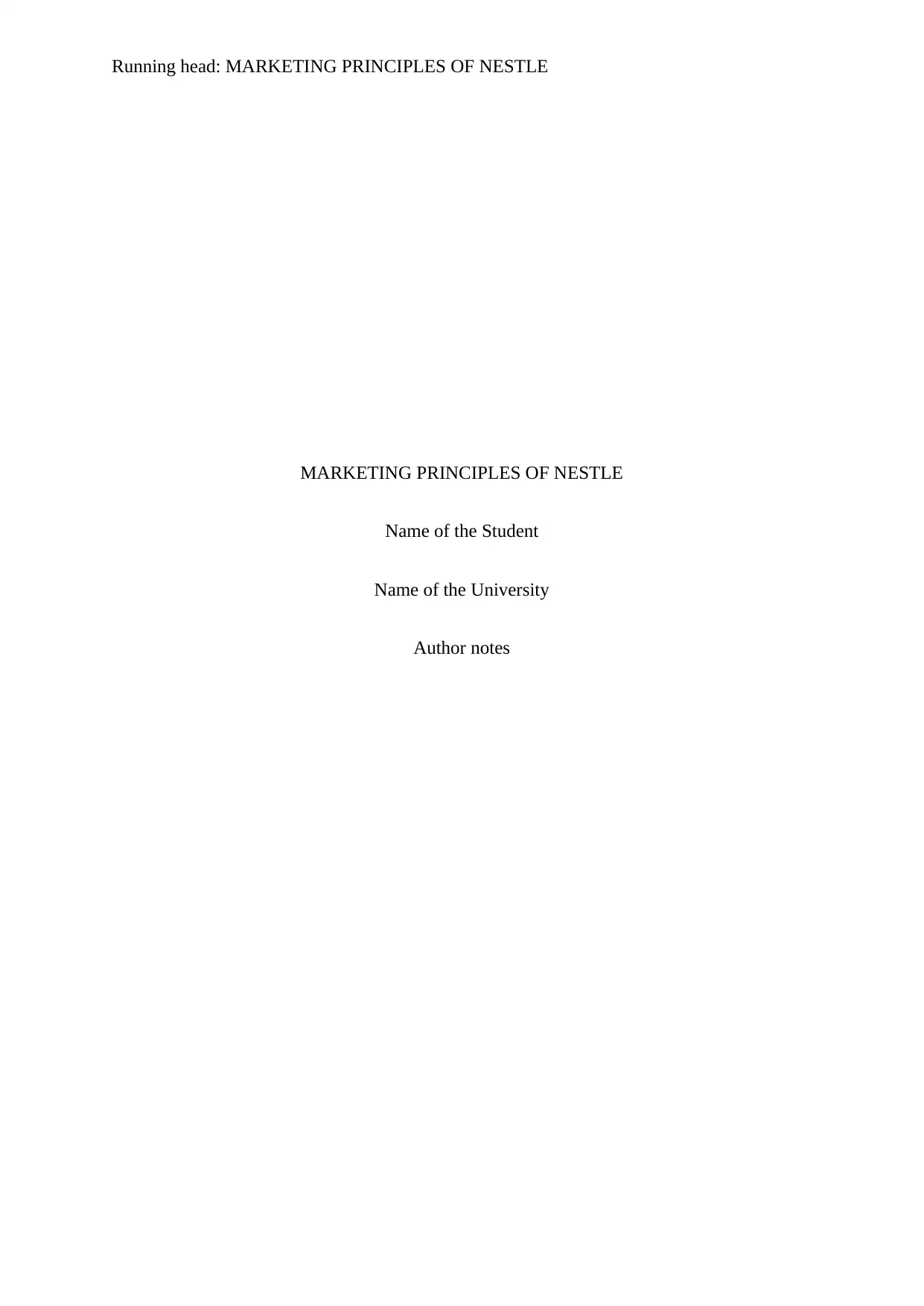
Running head: MARKETING PRINCIPLES OF NESTLE
MARKETING PRINCIPLES OF NESTLE
Name of the Student
Name of the University
Author notes
MARKETING PRINCIPLES OF NESTLE
Name of the Student
Name of the University
Author notes
Paraphrase This Document
Need a fresh take? Get an instant paraphrase of this document with our AI Paraphraser
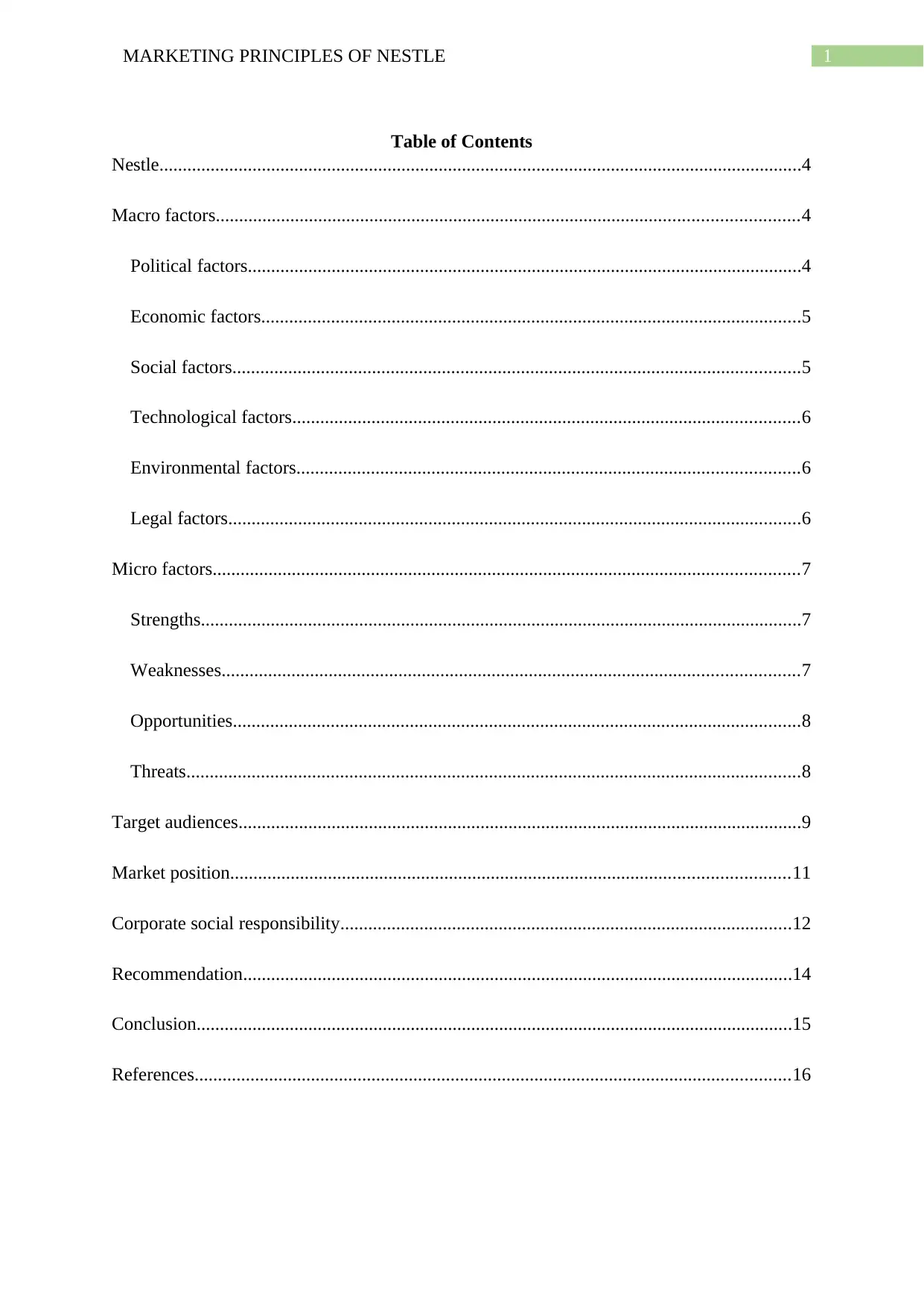
1MARKETING PRINCIPLES OF NESTLE
Table of Contents
Nestle..........................................................................................................................................4
Macro factors.............................................................................................................................4
Political factors.......................................................................................................................4
Economic factors....................................................................................................................5
Social factors..........................................................................................................................5
Technological factors.............................................................................................................6
Environmental factors............................................................................................................6
Legal factors...........................................................................................................................6
Micro factors..............................................................................................................................7
Strengths.................................................................................................................................7
Weaknesses............................................................................................................................7
Opportunities..........................................................................................................................8
Threats....................................................................................................................................8
Target audiences.........................................................................................................................9
Market position........................................................................................................................11
Corporate social responsibility.................................................................................................12
Recommendation......................................................................................................................14
Conclusion................................................................................................................................15
References................................................................................................................................16
Table of Contents
Nestle..........................................................................................................................................4
Macro factors.............................................................................................................................4
Political factors.......................................................................................................................4
Economic factors....................................................................................................................5
Social factors..........................................................................................................................5
Technological factors.............................................................................................................6
Environmental factors............................................................................................................6
Legal factors...........................................................................................................................6
Micro factors..............................................................................................................................7
Strengths.................................................................................................................................7
Weaknesses............................................................................................................................7
Opportunities..........................................................................................................................8
Threats....................................................................................................................................8
Target audiences.........................................................................................................................9
Market position........................................................................................................................11
Corporate social responsibility.................................................................................................12
Recommendation......................................................................................................................14
Conclusion................................................................................................................................15
References................................................................................................................................16
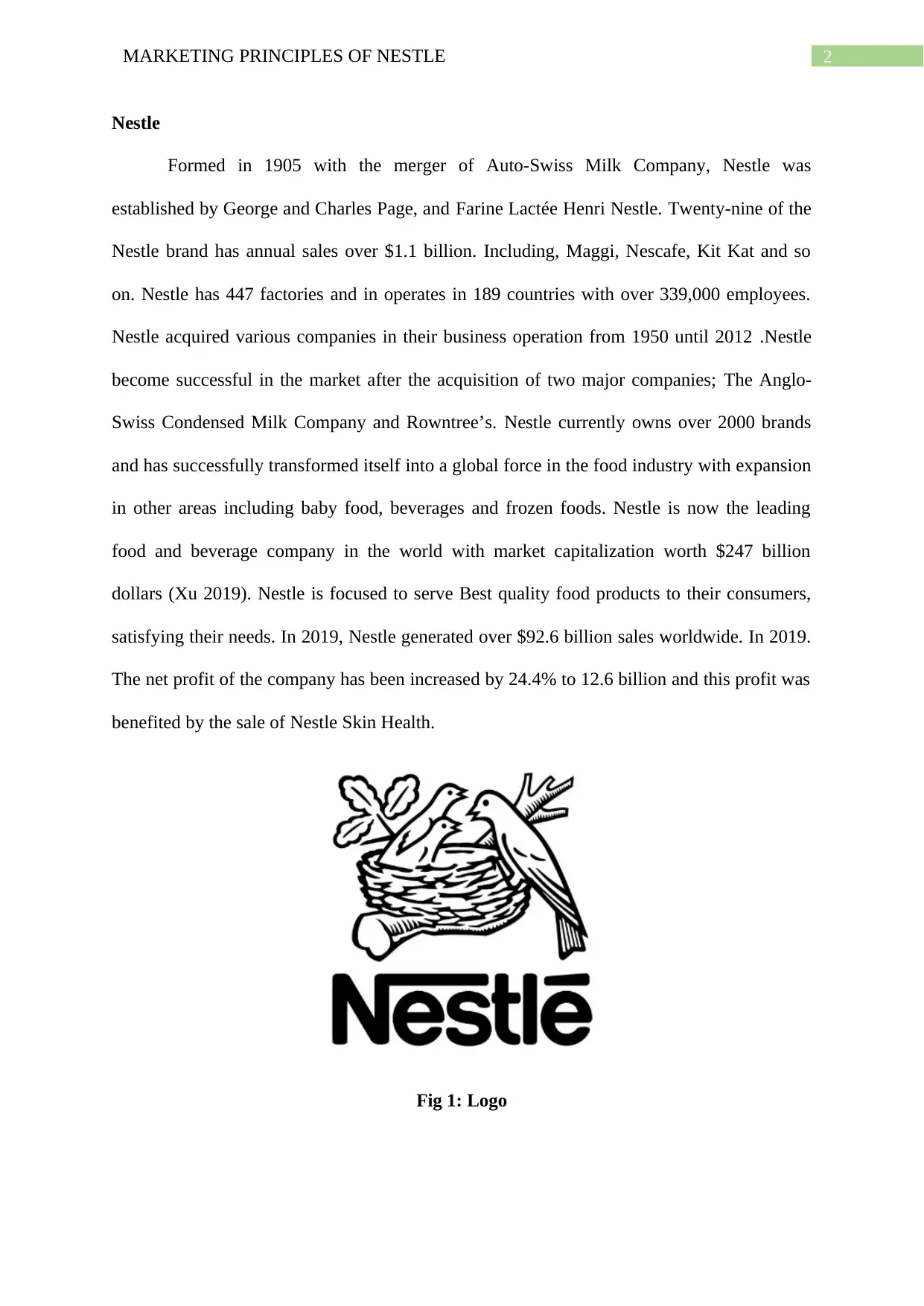
2MARKETING PRINCIPLES OF NESTLE
Nestle
Formed in 1905 with the merger of Auto-Swiss Milk Company, Nestle was
established by George and Charles Page, and Farine Lactée Henri Nestle. Twenty-nine of the
Nestle brand has annual sales over $1.1 billion. Including, Maggi, Nescafe, Kit Kat and so
on. Nestle has 447 factories and in operates in 189 countries with over 339,000 employees.
Nestle acquired various companies in their business operation from 1950 until 2012 .Nestle
become successful in the market after the acquisition of two major companies; The Anglo-
Swiss Condensed Milk Company and Rowntree’s. Nestle currently owns over 2000 brands
and has successfully transformed itself into a global force in the food industry with expansion
in other areas including baby food, beverages and frozen foods. Nestle is now the leading
food and beverage company in the world with market capitalization worth $247 billion
dollars (Xu 2019). Nestle is focused to serve Best quality food products to their consumers,
satisfying their needs. In 2019, Nestle generated over $92.6 billion sales worldwide. In 2019.
The net profit of the company has been increased by 24.4% to 12.6 billion and this profit was
benefited by the sale of Nestle Skin Health.
Fig 1: Logo
Nestle
Formed in 1905 with the merger of Auto-Swiss Milk Company, Nestle was
established by George and Charles Page, and Farine Lactée Henri Nestle. Twenty-nine of the
Nestle brand has annual sales over $1.1 billion. Including, Maggi, Nescafe, Kit Kat and so
on. Nestle has 447 factories and in operates in 189 countries with over 339,000 employees.
Nestle acquired various companies in their business operation from 1950 until 2012 .Nestle
become successful in the market after the acquisition of two major companies; The Anglo-
Swiss Condensed Milk Company and Rowntree’s. Nestle currently owns over 2000 brands
and has successfully transformed itself into a global force in the food industry with expansion
in other areas including baby food, beverages and frozen foods. Nestle is now the leading
food and beverage company in the world with market capitalization worth $247 billion
dollars (Xu 2019). Nestle is focused to serve Best quality food products to their consumers,
satisfying their needs. In 2019, Nestle generated over $92.6 billion sales worldwide. In 2019.
The net profit of the company has been increased by 24.4% to 12.6 billion and this profit was
benefited by the sale of Nestle Skin Health.
Fig 1: Logo
⊘ This is a preview!⊘
Do you want full access?
Subscribe today to unlock all pages.

Trusted by 1+ million students worldwide
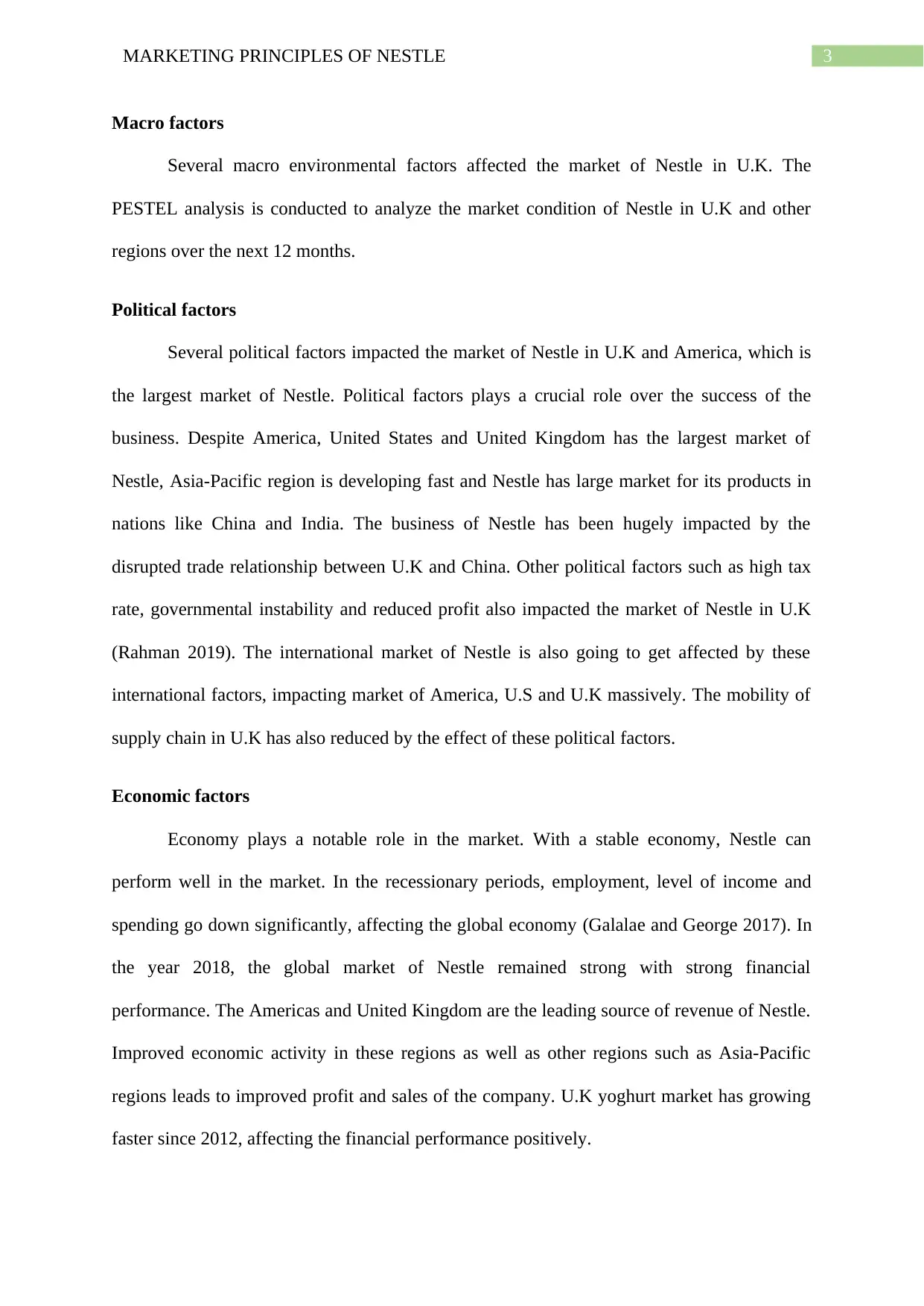
3MARKETING PRINCIPLES OF NESTLE
Macro factors
Several macro environmental factors affected the market of Nestle in U.K. The
PESTEL analysis is conducted to analyze the market condition of Nestle in U.K and other
regions over the next 12 months.
Political factors
Several political factors impacted the market of Nestle in U.K and America, which is
the largest market of Nestle. Political factors plays a crucial role over the success of the
business. Despite America, United States and United Kingdom has the largest market of
Nestle, Asia-Pacific region is developing fast and Nestle has large market for its products in
nations like China and India. The business of Nestle has been hugely impacted by the
disrupted trade relationship between U.K and China. Other political factors such as high tax
rate, governmental instability and reduced profit also impacted the market of Nestle in U.K
(Rahman 2019). The international market of Nestle is also going to get affected by these
international factors, impacting market of America, U.S and U.K massively. The mobility of
supply chain in U.K has also reduced by the effect of these political factors.
Economic factors
Economy plays a notable role in the market. With a stable economy, Nestle can
perform well in the market. In the recessionary periods, employment, level of income and
spending go down significantly, affecting the global economy (Galalae and George 2017). In
the year 2018, the global market of Nestle remained strong with strong financial
performance. The Americas and United Kingdom are the leading source of revenue of Nestle.
Improved economic activity in these regions as well as other regions such as Asia-Pacific
regions leads to improved profit and sales of the company. U.K yoghurt market has growing
faster since 2012, affecting the financial performance positively.
Macro factors
Several macro environmental factors affected the market of Nestle in U.K. The
PESTEL analysis is conducted to analyze the market condition of Nestle in U.K and other
regions over the next 12 months.
Political factors
Several political factors impacted the market of Nestle in U.K and America, which is
the largest market of Nestle. Political factors plays a crucial role over the success of the
business. Despite America, United States and United Kingdom has the largest market of
Nestle, Asia-Pacific region is developing fast and Nestle has large market for its products in
nations like China and India. The business of Nestle has been hugely impacted by the
disrupted trade relationship between U.K and China. Other political factors such as high tax
rate, governmental instability and reduced profit also impacted the market of Nestle in U.K
(Rahman 2019). The international market of Nestle is also going to get affected by these
international factors, impacting market of America, U.S and U.K massively. The mobility of
supply chain in U.K has also reduced by the effect of these political factors.
Economic factors
Economy plays a notable role in the market. With a stable economy, Nestle can
perform well in the market. In the recessionary periods, employment, level of income and
spending go down significantly, affecting the global economy (Galalae and George 2017). In
the year 2018, the global market of Nestle remained strong with strong financial
performance. The Americas and United Kingdom are the leading source of revenue of Nestle.
Improved economic activity in these regions as well as other regions such as Asia-Pacific
regions leads to improved profit and sales of the company. U.K yoghurt market has growing
faster since 2012, affecting the financial performance positively.
Paraphrase This Document
Need a fresh take? Get an instant paraphrase of this document with our AI Paraphraser
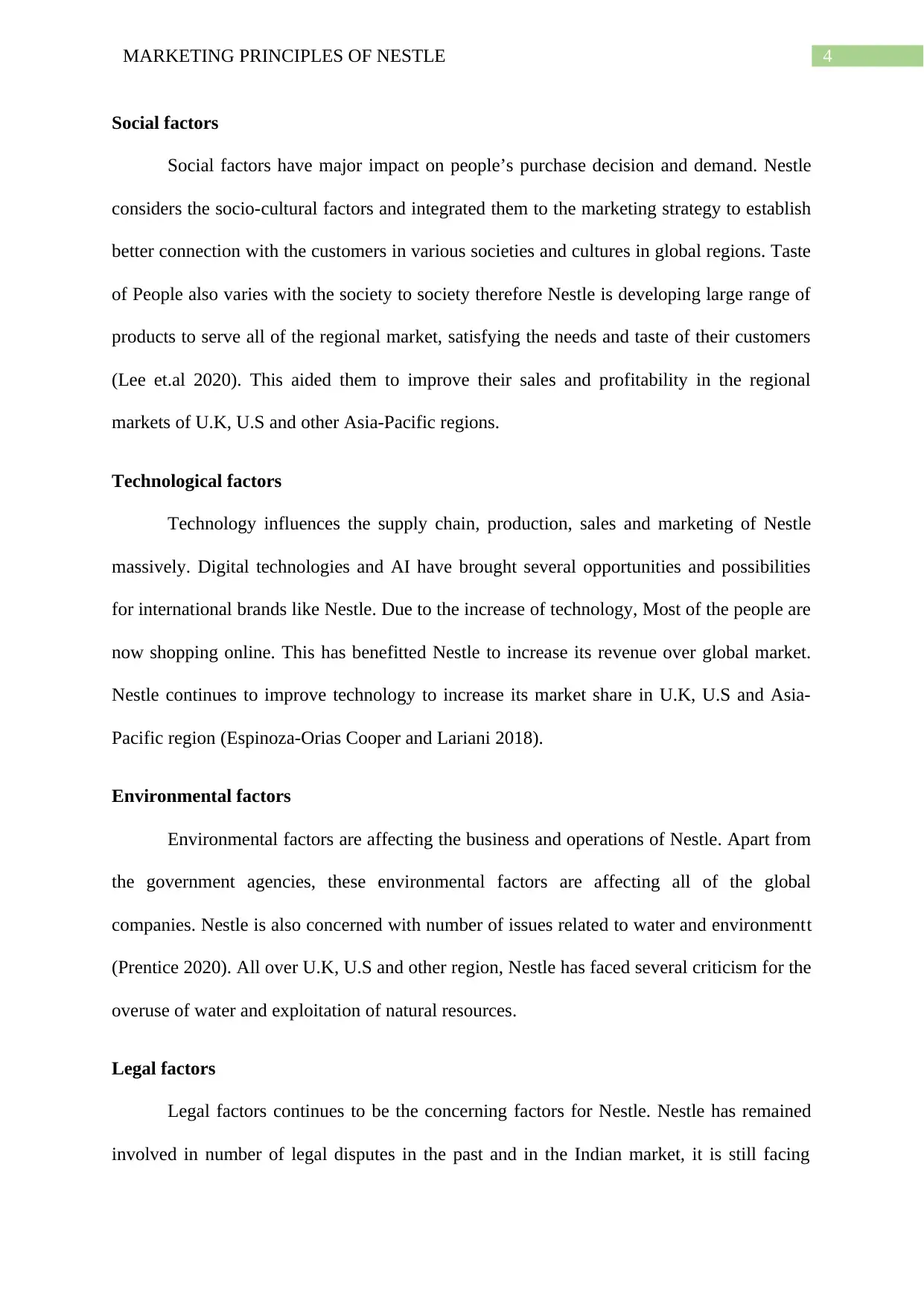
4MARKETING PRINCIPLES OF NESTLE
Social factors
Social factors have major impact on people’s purchase decision and demand. Nestle
considers the socio-cultural factors and integrated them to the marketing strategy to establish
better connection with the customers in various societies and cultures in global regions. Taste
of People also varies with the society to society therefore Nestle is developing large range of
products to serve all of the regional market, satisfying the needs and taste of their customers
(Lee et.al 2020). This aided them to improve their sales and profitability in the regional
markets of U.K, U.S and other Asia-Pacific regions.
Technological factors
Technology influences the supply chain, production, sales and marketing of Nestle
massively. Digital technologies and AI have brought several opportunities and possibilities
for international brands like Nestle. Due to the increase of technology, Most of the people are
now shopping online. This has benefitted Nestle to increase its revenue over global market.
Nestle continues to improve technology to increase its market share in U.K, U.S and Asia-
Pacific region (Espinoza-Orias Cooper and Lariani 2018).
Environmental factors
Environmental factors are affecting the business and operations of Nestle. Apart from
the government agencies, these environmental factors are affecting all of the global
companies. Nestle is also concerned with number of issues related to water and environmentt
(Prentice 2020). All over U.K, U.S and other region, Nestle has faced several criticism for the
overuse of water and exploitation of natural resources.
Legal factors
Legal factors continues to be the concerning factors for Nestle. Nestle has remained
involved in number of legal disputes in the past and in the Indian market, it is still facing
Social factors
Social factors have major impact on people’s purchase decision and demand. Nestle
considers the socio-cultural factors and integrated them to the marketing strategy to establish
better connection with the customers in various societies and cultures in global regions. Taste
of People also varies with the society to society therefore Nestle is developing large range of
products to serve all of the regional market, satisfying the needs and taste of their customers
(Lee et.al 2020). This aided them to improve their sales and profitability in the regional
markets of U.K, U.S and other Asia-Pacific regions.
Technological factors
Technology influences the supply chain, production, sales and marketing of Nestle
massively. Digital technologies and AI have brought several opportunities and possibilities
for international brands like Nestle. Due to the increase of technology, Most of the people are
now shopping online. This has benefitted Nestle to increase its revenue over global market.
Nestle continues to improve technology to increase its market share in U.K, U.S and Asia-
Pacific region (Espinoza-Orias Cooper and Lariani 2018).
Environmental factors
Environmental factors are affecting the business and operations of Nestle. Apart from
the government agencies, these environmental factors are affecting all of the global
companies. Nestle is also concerned with number of issues related to water and environmentt
(Prentice 2020). All over U.K, U.S and other region, Nestle has faced several criticism for the
overuse of water and exploitation of natural resources.
Legal factors
Legal factors continues to be the concerning factors for Nestle. Nestle has remained
involved in number of legal disputes in the past and in the Indian market, it is still facing
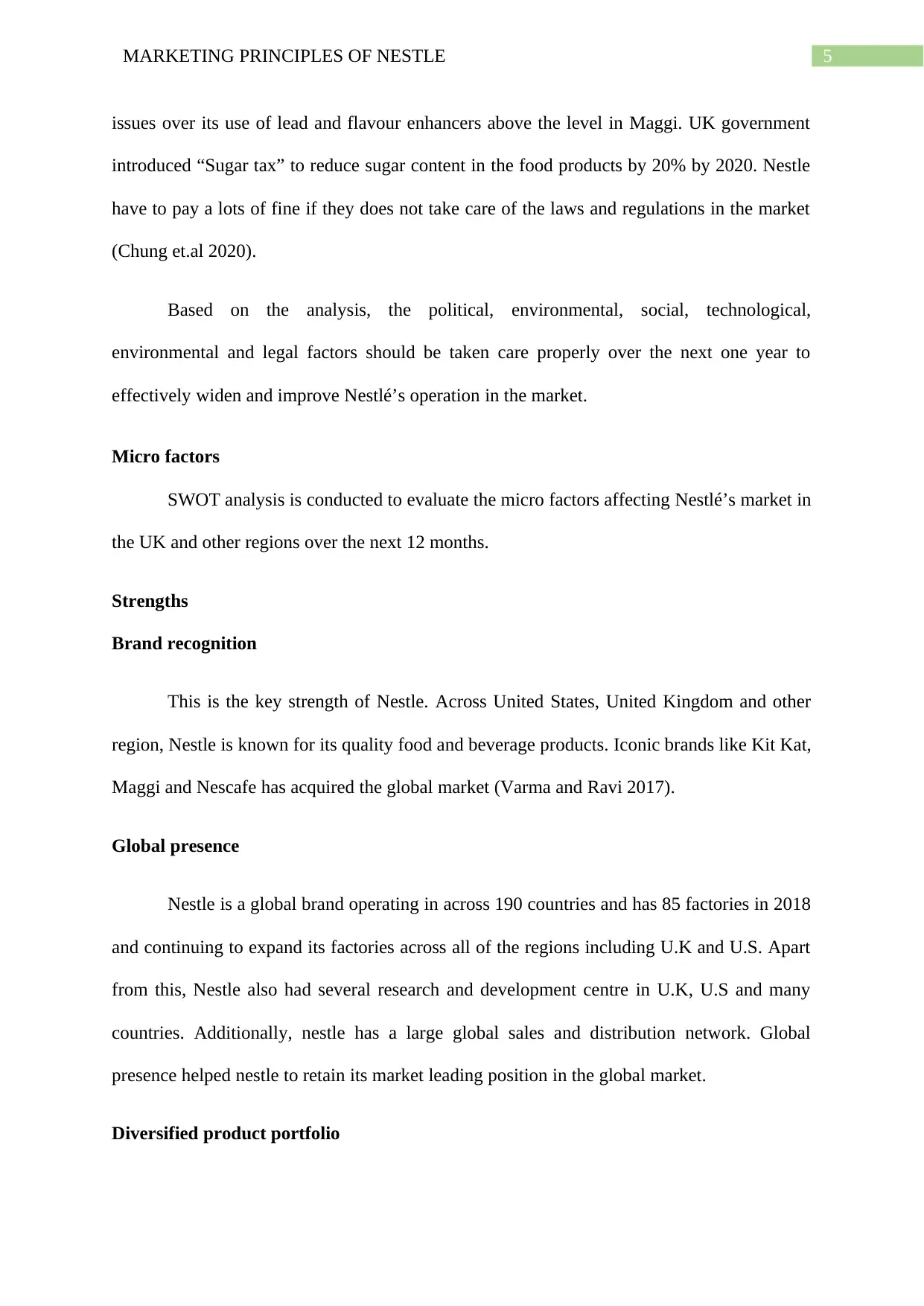
5MARKETING PRINCIPLES OF NESTLE
issues over its use of lead and flavour enhancers above the level in Maggi. UK government
introduced “Sugar tax” to reduce sugar content in the food products by 20% by 2020. Nestle
have to pay a lots of fine if they does not take care of the laws and regulations in the market
(Chung et.al 2020).
Based on the analysis, the political, environmental, social, technological,
environmental and legal factors should be taken care properly over the next one year to
effectively widen and improve Nestlé’s operation in the market.
Micro factors
SWOT analysis is conducted to evaluate the micro factors affecting Nestlé’s market in
the UK and other regions over the next 12 months.
Strengths
Brand recognition
This is the key strength of Nestle. Across United States, United Kingdom and other
region, Nestle is known for its quality food and beverage products. Iconic brands like Kit Kat,
Maggi and Nescafe has acquired the global market (Varma and Ravi 2017).
Global presence
Nestle is a global brand operating in across 190 countries and has 85 factories in 2018
and continuing to expand its factories across all of the regions including U.K and U.S. Apart
from this, Nestle also had several research and development centre in U.K, U.S and many
countries. Additionally, nestle has a large global sales and distribution network. Global
presence helped nestle to retain its market leading position in the global market.
Diversified product portfolio
issues over its use of lead and flavour enhancers above the level in Maggi. UK government
introduced “Sugar tax” to reduce sugar content in the food products by 20% by 2020. Nestle
have to pay a lots of fine if they does not take care of the laws and regulations in the market
(Chung et.al 2020).
Based on the analysis, the political, environmental, social, technological,
environmental and legal factors should be taken care properly over the next one year to
effectively widen and improve Nestlé’s operation in the market.
Micro factors
SWOT analysis is conducted to evaluate the micro factors affecting Nestlé’s market in
the UK and other regions over the next 12 months.
Strengths
Brand recognition
This is the key strength of Nestle. Across United States, United Kingdom and other
region, Nestle is known for its quality food and beverage products. Iconic brands like Kit Kat,
Maggi and Nescafe has acquired the global market (Varma and Ravi 2017).
Global presence
Nestle is a global brand operating in across 190 countries and has 85 factories in 2018
and continuing to expand its factories across all of the regions including U.K and U.S. Apart
from this, Nestle also had several research and development centre in U.K, U.S and many
countries. Additionally, nestle has a large global sales and distribution network. Global
presence helped nestle to retain its market leading position in the global market.
Diversified product portfolio
⊘ This is a preview!⊘
Do you want full access?
Subscribe today to unlock all pages.

Trusted by 1+ million students worldwide
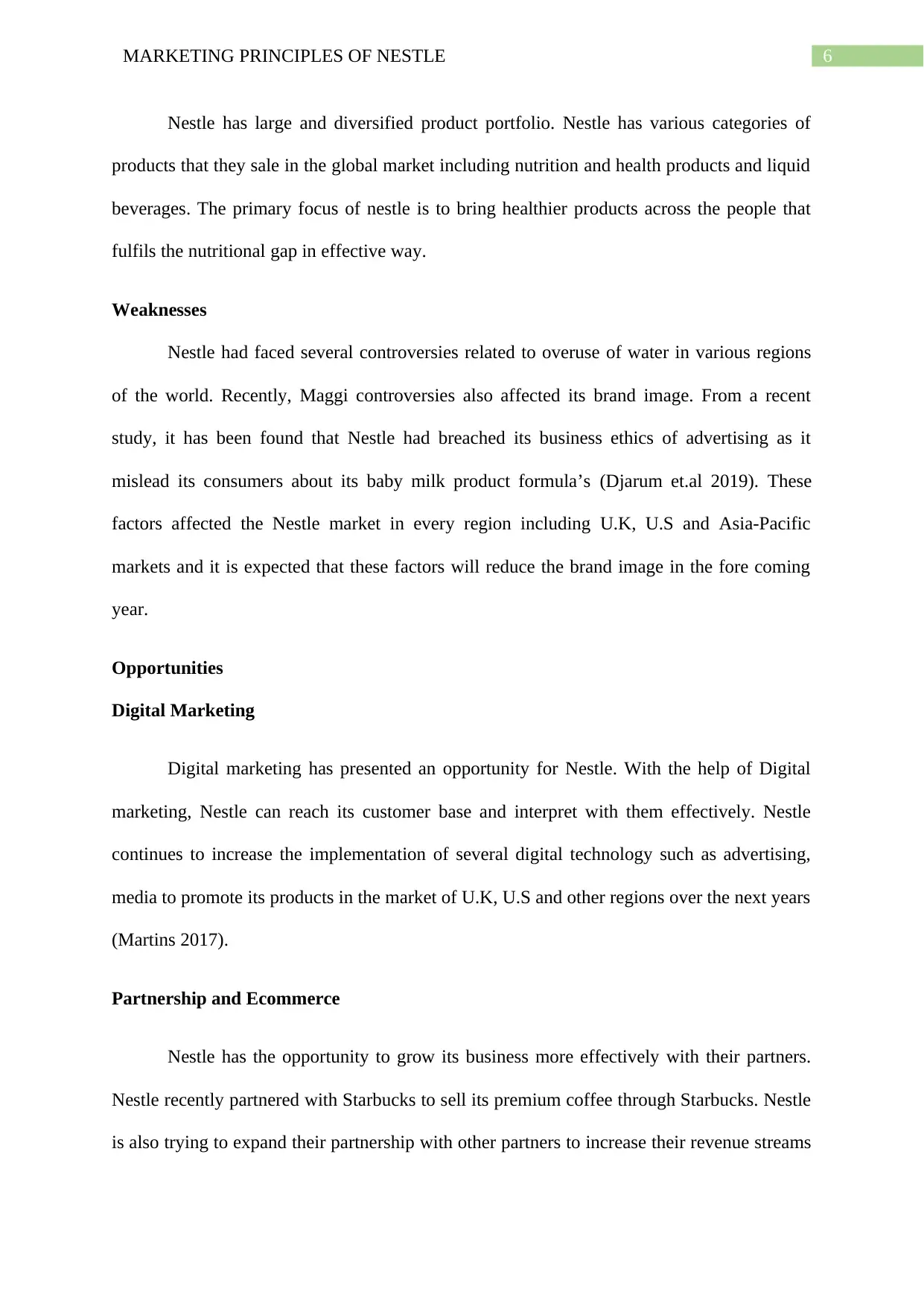
6MARKETING PRINCIPLES OF NESTLE
Nestle has large and diversified product portfolio. Nestle has various categories of
products that they sale in the global market including nutrition and health products and liquid
beverages. The primary focus of nestle is to bring healthier products across the people that
fulfils the nutritional gap in effective way.
Weaknesses
Nestle had faced several controversies related to overuse of water in various regions
of the world. Recently, Maggi controversies also affected its brand image. From a recent
study, it has been found that Nestle had breached its business ethics of advertising as it
mislead its consumers about its baby milk product formula’s (Djarum et.al 2019). These
factors affected the Nestle market in every region including U.K, U.S and Asia-Pacific
markets and it is expected that these factors will reduce the brand image in the fore coming
year.
Opportunities
Digital Marketing
Digital marketing has presented an opportunity for Nestle. With the help of Digital
marketing, Nestle can reach its customer base and interpret with them effectively. Nestle
continues to increase the implementation of several digital technology such as advertising,
media to promote its products in the market of U.K, U.S and other regions over the next years
(Martins 2017).
Partnership and Ecommerce
Nestle has the opportunity to grow its business more effectively with their partners.
Nestle recently partnered with Starbucks to sell its premium coffee through Starbucks. Nestle
is also trying to expand their partnership with other partners to increase their revenue streams
Nestle has large and diversified product portfolio. Nestle has various categories of
products that they sale in the global market including nutrition and health products and liquid
beverages. The primary focus of nestle is to bring healthier products across the people that
fulfils the nutritional gap in effective way.
Weaknesses
Nestle had faced several controversies related to overuse of water in various regions
of the world. Recently, Maggi controversies also affected its brand image. From a recent
study, it has been found that Nestle had breached its business ethics of advertising as it
mislead its consumers about its baby milk product formula’s (Djarum et.al 2019). These
factors affected the Nestle market in every region including U.K, U.S and Asia-Pacific
markets and it is expected that these factors will reduce the brand image in the fore coming
year.
Opportunities
Digital Marketing
Digital marketing has presented an opportunity for Nestle. With the help of Digital
marketing, Nestle can reach its customer base and interpret with them effectively. Nestle
continues to increase the implementation of several digital technology such as advertising,
media to promote its products in the market of U.K, U.S and other regions over the next years
(Martins 2017).
Partnership and Ecommerce
Nestle has the opportunity to grow its business more effectively with their partners.
Nestle recently partnered with Starbucks to sell its premium coffee through Starbucks. Nestle
is also trying to expand their partnership with other partners to increase their revenue streams
Paraphrase This Document
Need a fresh take? Get an instant paraphrase of this document with our AI Paraphraser
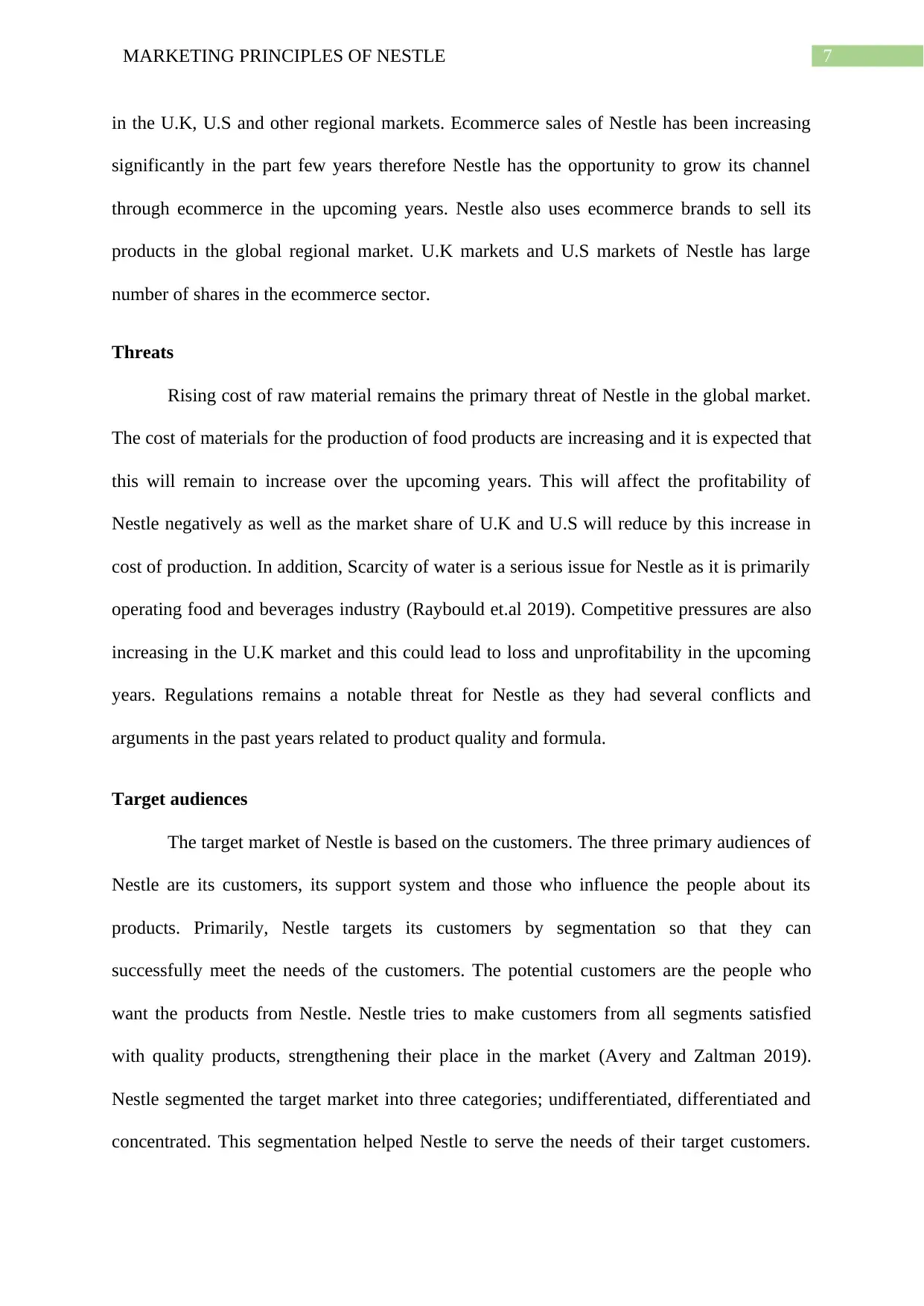
7MARKETING PRINCIPLES OF NESTLE
in the U.K, U.S and other regional markets. Ecommerce sales of Nestle has been increasing
significantly in the part few years therefore Nestle has the opportunity to grow its channel
through ecommerce in the upcoming years. Nestle also uses ecommerce brands to sell its
products in the global regional market. U.K markets and U.S markets of Nestle has large
number of shares in the ecommerce sector.
Threats
Rising cost of raw material remains the primary threat of Nestle in the global market.
The cost of materials for the production of food products are increasing and it is expected that
this will remain to increase over the upcoming years. This will affect the profitability of
Nestle negatively as well as the market share of U.K and U.S will reduce by this increase in
cost of production. In addition, Scarcity of water is a serious issue for Nestle as it is primarily
operating food and beverages industry (Raybould et.al 2019). Competitive pressures are also
increasing in the U.K market and this could lead to loss and unprofitability in the upcoming
years. Regulations remains a notable threat for Nestle as they had several conflicts and
arguments in the past years related to product quality and formula.
Target audiences
The target market of Nestle is based on the customers. The three primary audiences of
Nestle are its customers, its support system and those who influence the people about its
products. Primarily, Nestle targets its customers by segmentation so that they can
successfully meet the needs of the customers. The potential customers are the people who
want the products from Nestle. Nestle tries to make customers from all segments satisfied
with quality products, strengthening their place in the market (Avery and Zaltman 2019).
Nestle segmented the target market into three categories; undifferentiated, differentiated and
concentrated. This segmentation helped Nestle to serve the needs of their target customers.
in the U.K, U.S and other regional markets. Ecommerce sales of Nestle has been increasing
significantly in the part few years therefore Nestle has the opportunity to grow its channel
through ecommerce in the upcoming years. Nestle also uses ecommerce brands to sell its
products in the global regional market. U.K markets and U.S markets of Nestle has large
number of shares in the ecommerce sector.
Threats
Rising cost of raw material remains the primary threat of Nestle in the global market.
The cost of materials for the production of food products are increasing and it is expected that
this will remain to increase over the upcoming years. This will affect the profitability of
Nestle negatively as well as the market share of U.K and U.S will reduce by this increase in
cost of production. In addition, Scarcity of water is a serious issue for Nestle as it is primarily
operating food and beverages industry (Raybould et.al 2019). Competitive pressures are also
increasing in the U.K market and this could lead to loss and unprofitability in the upcoming
years. Regulations remains a notable threat for Nestle as they had several conflicts and
arguments in the past years related to product quality and formula.
Target audiences
The target market of Nestle is based on the customers. The three primary audiences of
Nestle are its customers, its support system and those who influence the people about its
products. Primarily, Nestle targets its customers by segmentation so that they can
successfully meet the needs of the customers. The potential customers are the people who
want the products from Nestle. Nestle tries to make customers from all segments satisfied
with quality products, strengthening their place in the market (Avery and Zaltman 2019).
Nestle segmented the target market into three categories; undifferentiated, differentiated and
concentrated. This segmentation helped Nestle to serve the needs of their target customers.
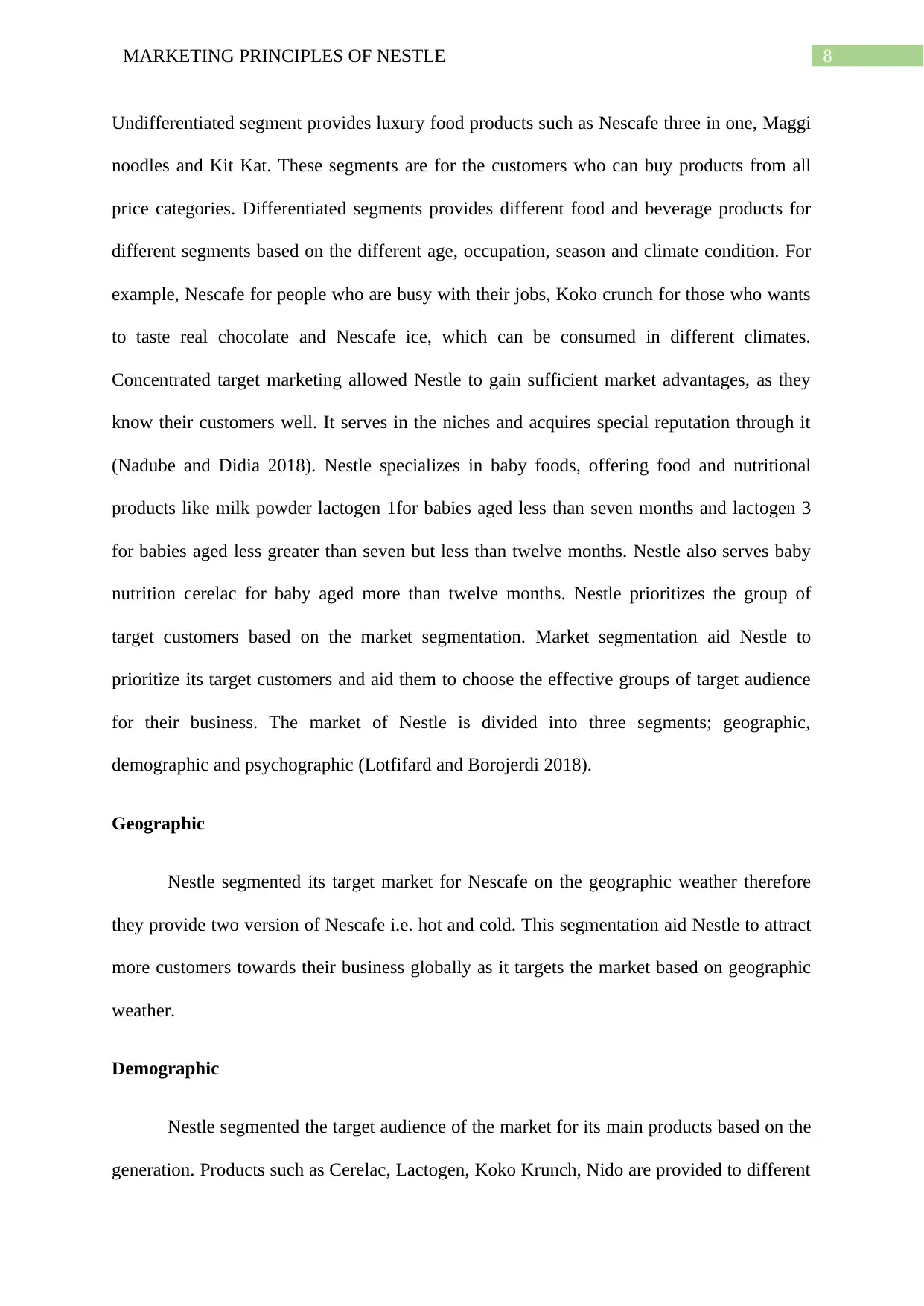
8MARKETING PRINCIPLES OF NESTLE
Undifferentiated segment provides luxury food products such as Nescafe three in one, Maggi
noodles and Kit Kat. These segments are for the customers who can buy products from all
price categories. Differentiated segments provides different food and beverage products for
different segments based on the different age, occupation, season and climate condition. For
example, Nescafe for people who are busy with their jobs, Koko crunch for those who wants
to taste real chocolate and Nescafe ice, which can be consumed in different climates.
Concentrated target marketing allowed Nestle to gain sufficient market advantages, as they
know their customers well. It serves in the niches and acquires special reputation through it
(Nadube and Didia 2018). Nestle specializes in baby foods, offering food and nutritional
products like milk powder lactogen 1for babies aged less than seven months and lactogen 3
for babies aged less greater than seven but less than twelve months. Nestle also serves baby
nutrition cerelac for baby aged more than twelve months. Nestle prioritizes the group of
target customers based on the market segmentation. Market segmentation aid Nestle to
prioritize its target customers and aid them to choose the effective groups of target audience
for their business. The market of Nestle is divided into three segments; geographic,
demographic and psychographic (Lotfifard and Borojerdi 2018).
Geographic
Nestle segmented its target market for Nescafe on the geographic weather therefore
they provide two version of Nescafe i.e. hot and cold. This segmentation aid Nestle to attract
more customers towards their business globally as it targets the market based on geographic
weather.
Demographic
Nestle segmented the target audience of the market for its main products based on the
generation. Products such as Cerelac, Lactogen, Koko Krunch, Nido are provided to different
Undifferentiated segment provides luxury food products such as Nescafe three in one, Maggi
noodles and Kit Kat. These segments are for the customers who can buy products from all
price categories. Differentiated segments provides different food and beverage products for
different segments based on the different age, occupation, season and climate condition. For
example, Nescafe for people who are busy with their jobs, Koko crunch for those who wants
to taste real chocolate and Nescafe ice, which can be consumed in different climates.
Concentrated target marketing allowed Nestle to gain sufficient market advantages, as they
know their customers well. It serves in the niches and acquires special reputation through it
(Nadube and Didia 2018). Nestle specializes in baby foods, offering food and nutritional
products like milk powder lactogen 1for babies aged less than seven months and lactogen 3
for babies aged less greater than seven but less than twelve months. Nestle also serves baby
nutrition cerelac for baby aged more than twelve months. Nestle prioritizes the group of
target customers based on the market segmentation. Market segmentation aid Nestle to
prioritize its target customers and aid them to choose the effective groups of target audience
for their business. The market of Nestle is divided into three segments; geographic,
demographic and psychographic (Lotfifard and Borojerdi 2018).
Geographic
Nestle segmented its target market for Nescafe on the geographic weather therefore
they provide two version of Nescafe i.e. hot and cold. This segmentation aid Nestle to attract
more customers towards their business globally as it targets the market based on geographic
weather.
Demographic
Nestle segmented the target audience of the market for its main products based on the
generation. Products such as Cerelac, Lactogen, Koko Krunch, Nido are provided to different
⊘ This is a preview!⊘
Do you want full access?
Subscribe today to unlock all pages.

Trusted by 1+ million students worldwide
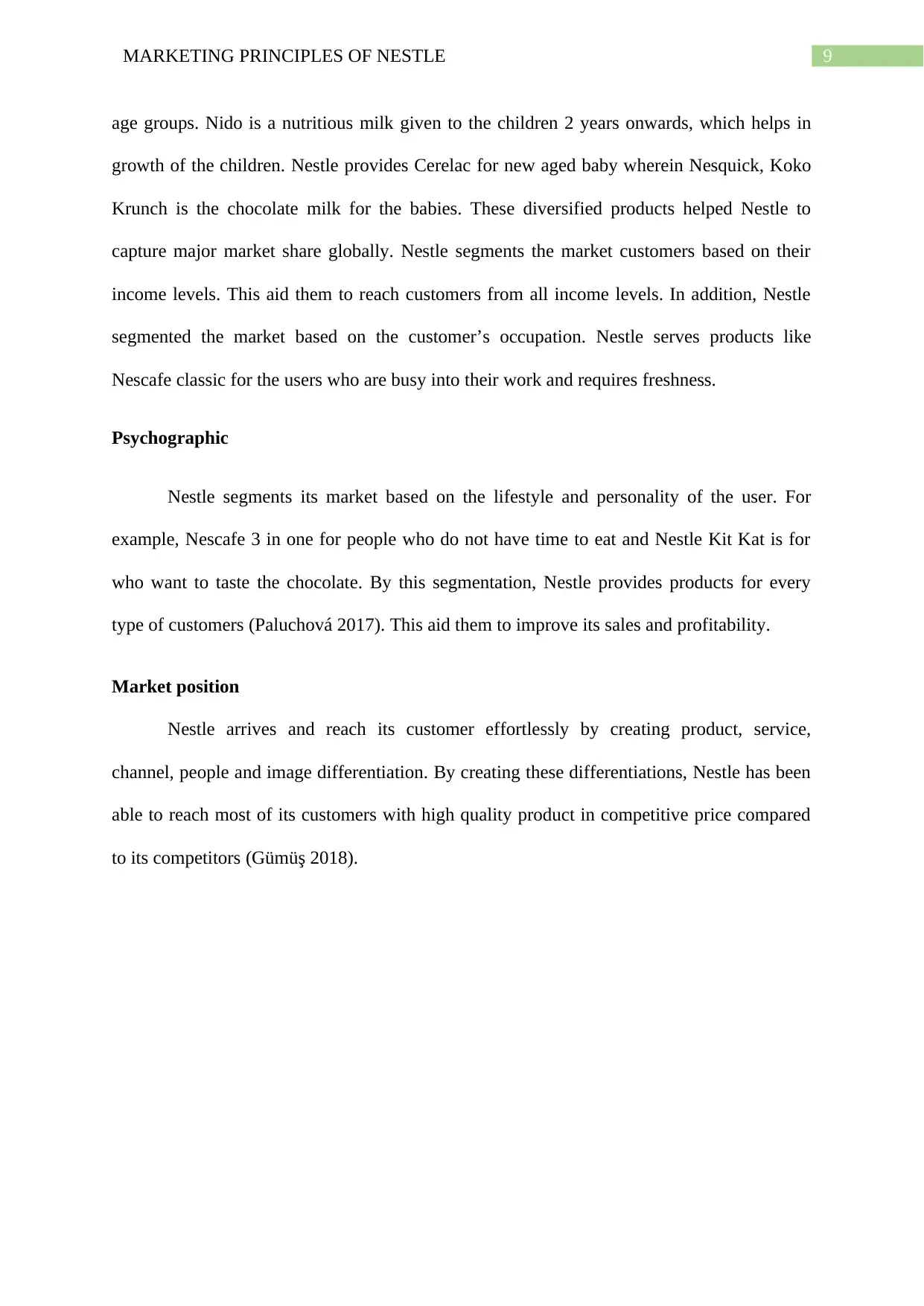
9MARKETING PRINCIPLES OF NESTLE
age groups. Nido is a nutritious milk given to the children 2 years onwards, which helps in
growth of the children. Nestle provides Cerelac for new aged baby wherein Nesquick, Koko
Krunch is the chocolate milk for the babies. These diversified products helped Nestle to
capture major market share globally. Nestle segments the market customers based on their
income levels. This aid them to reach customers from all income levels. In addition, Nestle
segmented the market based on the customer’s occupation. Nestle serves products like
Nescafe classic for the users who are busy into their work and requires freshness.
Psychographic
Nestle segments its market based on the lifestyle and personality of the user. For
example, Nescafe 3 in one for people who do not have time to eat and Nestle Kit Kat is for
who want to taste the chocolate. By this segmentation, Nestle provides products for every
type of customers (Paluchová 2017). This aid them to improve its sales and profitability.
Market position
Nestle arrives and reach its customer effortlessly by creating product, service,
channel, people and image differentiation. By creating these differentiations, Nestle has been
able to reach most of its customers with high quality product in competitive price compared
to its competitors (Gümüş 2018).
age groups. Nido is a nutritious milk given to the children 2 years onwards, which helps in
growth of the children. Nestle provides Cerelac for new aged baby wherein Nesquick, Koko
Krunch is the chocolate milk for the babies. These diversified products helped Nestle to
capture major market share globally. Nestle segments the market customers based on their
income levels. This aid them to reach customers from all income levels. In addition, Nestle
segmented the market based on the customer’s occupation. Nestle serves products like
Nescafe classic for the users who are busy into their work and requires freshness.
Psychographic
Nestle segments its market based on the lifestyle and personality of the user. For
example, Nescafe 3 in one for people who do not have time to eat and Nestle Kit Kat is for
who want to taste the chocolate. By this segmentation, Nestle provides products for every
type of customers (Paluchová 2017). This aid them to improve its sales and profitability.
Market position
Nestle arrives and reach its customer effortlessly by creating product, service,
channel, people and image differentiation. By creating these differentiations, Nestle has been
able to reach most of its customers with high quality product in competitive price compared
to its competitors (Gümüş 2018).
Paraphrase This Document
Need a fresh take? Get an instant paraphrase of this document with our AI Paraphraser
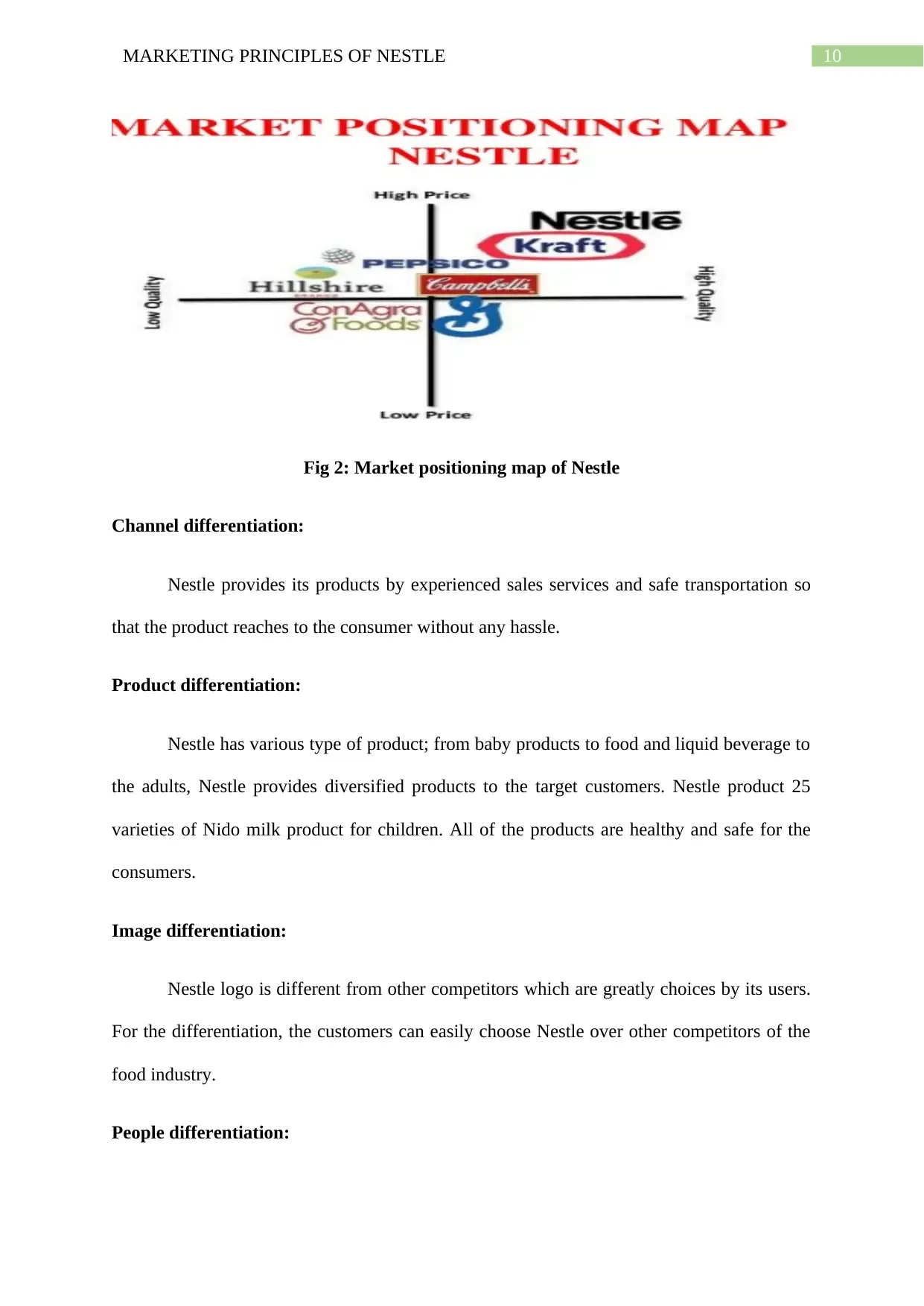
10MARKETING PRINCIPLES OF NESTLE
Fig 2: Market positioning map of Nestle
Channel differentiation:
Nestle provides its products by experienced sales services and safe transportation so
that the product reaches to the consumer without any hassle.
Product differentiation:
Nestle has various type of product; from baby products to food and liquid beverage to
the adults, Nestle provides diversified products to the target customers. Nestle product 25
varieties of Nido milk product for children. All of the products are healthy and safe for the
consumers.
Image differentiation:
Nestle logo is different from other competitors which are greatly choices by its users.
For the differentiation, the customers can easily choose Nestle over other competitors of the
food industry.
People differentiation:
Fig 2: Market positioning map of Nestle
Channel differentiation:
Nestle provides its products by experienced sales services and safe transportation so
that the product reaches to the consumer without any hassle.
Product differentiation:
Nestle has various type of product; from baby products to food and liquid beverage to
the adults, Nestle provides diversified products to the target customers. Nestle product 25
varieties of Nido milk product for children. All of the products are healthy and safe for the
consumers.
Image differentiation:
Nestle logo is different from other competitors which are greatly choices by its users.
For the differentiation, the customers can easily choose Nestle over other competitors of the
food industry.
People differentiation:
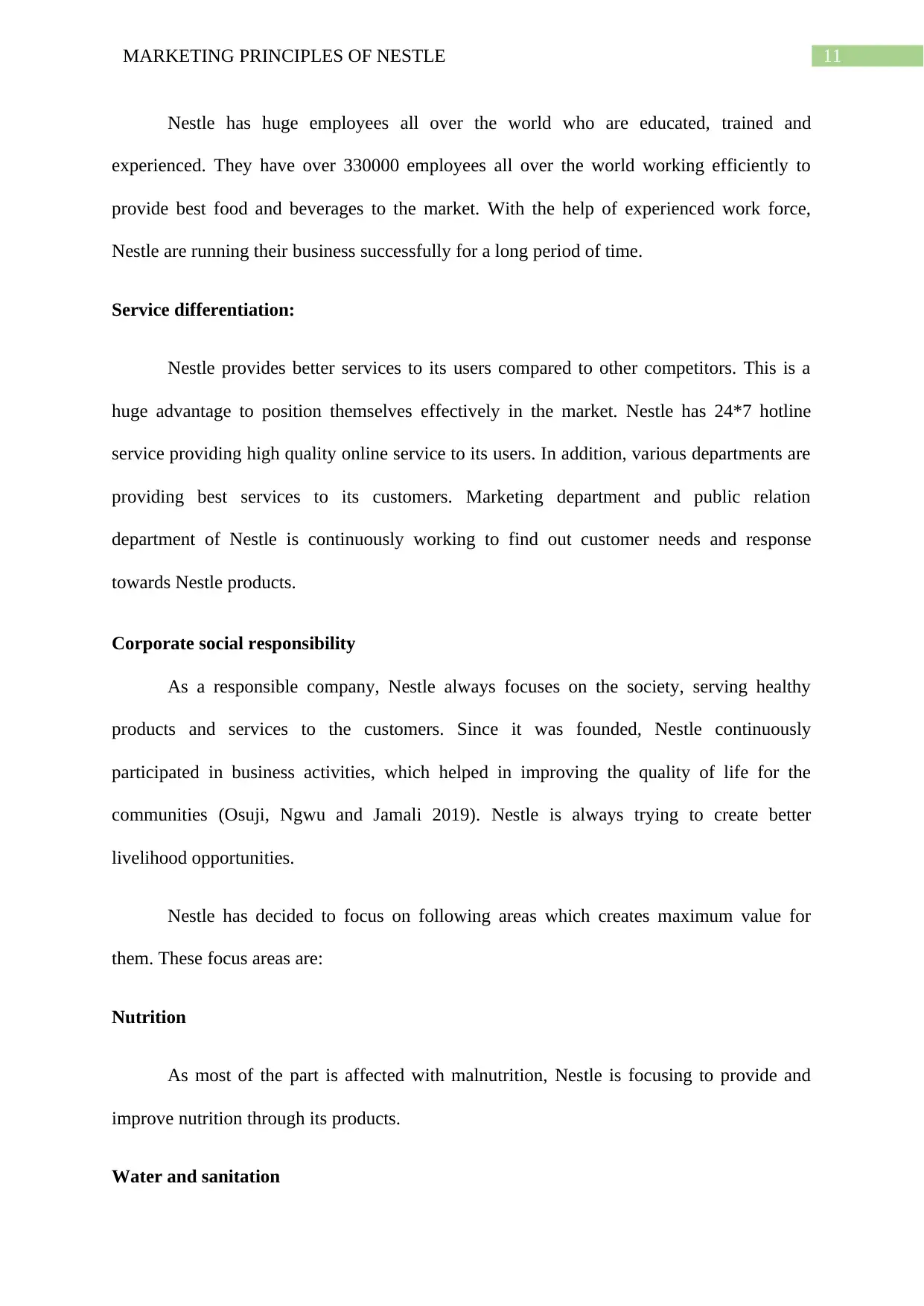
11MARKETING PRINCIPLES OF NESTLE
Nestle has huge employees all over the world who are educated, trained and
experienced. They have over 330000 employees all over the world working efficiently to
provide best food and beverages to the market. With the help of experienced work force,
Nestle are running their business successfully for a long period of time.
Service differentiation:
Nestle provides better services to its users compared to other competitors. This is a
huge advantage to position themselves effectively in the market. Nestle has 24*7 hotline
service providing high quality online service to its users. In addition, various departments are
providing best services to its customers. Marketing department and public relation
department of Nestle is continuously working to find out customer needs and response
towards Nestle products.
Corporate social responsibility
As a responsible company, Nestle always focuses on the society, serving healthy
products and services to the customers. Since it was founded, Nestle continuously
participated in business activities, which helped in improving the quality of life for the
communities (Osuji, Ngwu and Jamali 2019). Nestle is always trying to create better
livelihood opportunities.
Nestle has decided to focus on following areas which creates maximum value for
them. These focus areas are:
Nutrition
As most of the part is affected with malnutrition, Nestle is focusing to provide and
improve nutrition through its products.
Water and sanitation
Nestle has huge employees all over the world who are educated, trained and
experienced. They have over 330000 employees all over the world working efficiently to
provide best food and beverages to the market. With the help of experienced work force,
Nestle are running their business successfully for a long period of time.
Service differentiation:
Nestle provides better services to its users compared to other competitors. This is a
huge advantage to position themselves effectively in the market. Nestle has 24*7 hotline
service providing high quality online service to its users. In addition, various departments are
providing best services to its customers. Marketing department and public relation
department of Nestle is continuously working to find out customer needs and response
towards Nestle products.
Corporate social responsibility
As a responsible company, Nestle always focuses on the society, serving healthy
products and services to the customers. Since it was founded, Nestle continuously
participated in business activities, which helped in improving the quality of life for the
communities (Osuji, Ngwu and Jamali 2019). Nestle is always trying to create better
livelihood opportunities.
Nestle has decided to focus on following areas which creates maximum value for
them. These focus areas are:
Nutrition
As most of the part is affected with malnutrition, Nestle is focusing to provide and
improve nutrition through its products.
Water and sanitation
⊘ This is a preview!⊘
Do you want full access?
Subscribe today to unlock all pages.

Trusted by 1+ million students worldwide
1 out of 18
Related Documents
Your All-in-One AI-Powered Toolkit for Academic Success.
+13062052269
info@desklib.com
Available 24*7 on WhatsApp / Email
![[object Object]](/_next/static/media/star-bottom.7253800d.svg)
Unlock your academic potential
Copyright © 2020–2025 A2Z Services. All Rights Reserved. Developed and managed by ZUCOL.





